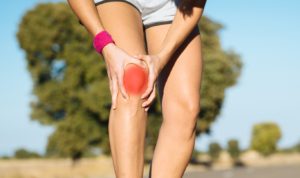Patellar Subluxation

What is patellar subluxation?
Subluxation means to temporarily and partially dislocate from a normal position. Patellar subluxation occurs when the knee cap (patella) moves out of its normal groove on the end of the femur (thigh bone). The subluxation can occur to either side of the knee (medial or lateral). Patellar subluxation is associated with patello-femoral pain syndrome, the most common running-related injury.
What causes patellar subluxation?
Patellar subluxation generally occurs when the knee is straightened. The cause is generally poor alignment in the leg or muscle weakness in the thigh. In some individuals, the leg bones above and below the knee angle inwards or outwards at the knee. This causes an atypical alignment of the tendons and ligaments that hold the patella in place on the front of the knee. In cases of muscle weakness, the patella can be pulled to one side or the other depending on which side the stronger thigh muscle is located.
What are the symptoms of patellar subluxation?
Patellar subluxation can cause swelling on the front of the knee and pain behind the knee cap. In some cases, there is pain above and below the knee as well. Symptoms are worsened with flexion and extension of the knee. For runners, this generally involves training on hills (up or down), trails, or during cross-training at the gym.
How is patellar subluxation diagnosed?
A clinical examination by a doctor or physical therapist is important in the diagnosis of patellar subluxation. In many cases, the doctor or therapist can reproduce the subluxation by applying pressure to the patella while extending or flexing the knee. An x-ray is useful to evaluate for arthritis, bone spurs, and the overall development and shape of the knee bones. An MRI is sometimes needed to evaluate for other problems in and around the knee that may mimic patellar subluxation.
What is patellar subluxation treated?
The goals in treating patellar subluxation include reducing inflammation and pain, but more importantly improving the biomechanics around the knee must be addressed. Inflammation is best addressed with ice and anti-inflammatory medications (NSAIDs). Occasionally, a cortisone injection into the knee joint is needed to reduce the pain and inflammation. Knee braces and taping can improve the alignment of the patella temporarily. In the end, improving strength and flexibility of the muscles around the knee joint will improve the biomechanics of the joint. We highly recommend a good clinical examination follow by physical therapy to pinpoint the root causes of the patellar subluxation and treat it accordingly. In cases where the bone alignment is abnormal, consultation with an orthopedic surgeon is wise.
When can you return to running?
The goal of rehabilitation is return you to running as soon as is safely possible. If you return to a full training load too soon, the injury may return or worsen. Everyone recovers from injury at a different rate, so don’t compare your rehabilitation to other runners. Returning to running is determined by how well your knee responds to treatment rather than a set number of days or weeks. In general, the longer you have had the symptoms, the longer it will take you to recover. Here are some general guidelines for a full return to running. Keep in mind, some runners may not have to completely stop running, but merely reduce their training load (distance, intensity, frequency) during the rehabilitation process.
- You should be able to bend and straighten your knee without pain.
- Your knee should not be swollen.
- You should be able to jog in a straight line without limping.
- You should be able to sprint without limping.
- You should be able to perform 45-degree and 90-degree cuts without difficulty.
- You should be able to jump on both legs without pain.
- You should able to jump on the injured leg without pain.
If you develop pain and swelling in the knee after returning to running, consulting with your doctor or therapist is important.
What can be done to reduce the chances of developing patellar subluxation?
The most important factor in preventing patellar tendonitis involves addressing the root causes. What are the root causes? It is generally accepted that more than half of all running injuries involve errors in training. This could include total mileage, running intensity, increasing the intensity and mileage too quickly, and finally the physical terrain (hills, trails, etc.). Improving areas of biomechanical deficiency also is important. This involves consistent focus on strength and flexibility of the hips, legs, ankles, and feet.
This information is not intended to diagnose, treat, or prevent any injury or disease. It is intended to serve as an overview of running-related injuries and should not be used as a substitute for sound medical advice from a doctor or therapist.


